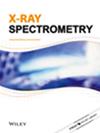《基督的哀歌》(约1460年,Mauritshuis)的材料和技术,归功于Rogier van der Weyden和工作室:结合了MA - XRF,反射成像光谱和油漆截面分析
IF 1.5
4区 物理与天体物理
Q3 SPECTROSCOPY
引用次数: 0
摘要
本文重点介绍了在最近的保护处理期间,由Rogier van der Weyden和工作室进行的《基督的哀歌》(约1460年,Mauritshuis)的技术检查。研究的目的是利用来自非侵入性化学制图和横断面分析的信息,识别和绘制用于人物最终油漆和底漆的颜料,以支持这幅画的现有归属。结果来自MA - XRF扫描仪和两台高光谱反射成像相机(400-1000 nm;967-1680 nm),加上最近的油漆截面分析和20世纪80年代收集的数据,可以全面了解所使用的颜料及其分布。总的来说,结果表明艺术家使用有限的调色板实现了各种各样的彩色帷幔(长袍)的人物。在不同的蓝色窗帘中发现了高品质的深蓝色和粗蓝铜矿,而蓝铜矿也与红湖和铅白结合,生产出淡紫色和紫色色调的织物。绿色长袍含有另一种铜颜料,铜绿,与铅锡黄结合。不同的红色帷幕显示出细微的色调差异,这是由不同的层地层和铅白、朱红色和红色湖泊的比例所获得的。化学地图也为一些帷幔的原始外观和模型提供了新的见解,包括发现含有(部分褪色的)红色湖泊的不寻常的棕色连衣裙。与之前的技术研究相比,《哀歌》所用的材料和精心制作的结构与Rogier van der Weyden及其工作室的其他画作一致。本文章由计算机程序翻译,如有差异,请以英文原文为准。
The materials and techniques of The Lamentation of Christ (ca. 1460, Mauritshuis), attributed to Rogier van der Weyden and studio: Combining MA‐XRF , reflectance imaging spectroscopy and paint cross‐section analysis
Abstract This article highlights a technical examination of The Lamentation of Christ (ca. 1460, Mauritshuis) attributed to Rogier van der Weyden and studio, performed during its recent conservation treatment. The goal of the research was to identify and map pigments used for the final paint and underpaint of the figures using information from non‐invasive chemical mapping and analysis of cross sections, to support the existing attribution of the painting. The results from a MA‐XRF scanner and two hyperspectral reflectance imaging cameras (400–1000 nm; 967–1680 nm) along with those from the analysis of recent paint cross sections and those collected in the 1980s allowed for a comprehensive understanding of the pigments used and their distribution. In general, the results show that the artist achieved a wide variety of colored draperies (robes) of the figures using a limited palette. High‐quality ultramarine and coarse azurite were identified in the different blue draperies, while azurite was also found combined with red lake and lead white to produce the lilac and purple‐toned fabrics. The green robe contains another copper pigment, verdigris, combined with lead‐tin yellow. The various red draperies show subtle differences in hue, obtained by varying the layer stratigraphy and proportions of lead white, vermilion, and red lake. The chemical maps also provided new insights into the original appearance and modeling of some of the draperies, including the unusual brown dress that was found to contain (partly faded) red lake. Comparison with previous technical studies shows that the materials and elaborate build‐ups used to paint The Lamentation are consistent with other paintings by Rogier van der Weyden and his workshop.
求助全文
通过发布文献求助,成功后即可免费获取论文全文。
去求助
来源期刊

X-Ray Spectrometry
物理-光谱学
CiteScore
3.10
自引率
8.30%
发文量
38
审稿时长
6-12 weeks
期刊介绍:
X-Ray Spectrometry is devoted to the rapid publication of papers dealing with the theory and application of x-ray spectrometry using electron, x-ray photon, proton, γ and γ-x sources.
Covering advances in techniques, methods and equipment, this established journal provides the ideal platform for the discussion of more sophisticated X-ray analytical methods.
Both wavelength and energy dispersion systems are covered together with a range of data handling methods, from the most simple to very sophisticated software programs. Papers dealing with the application of x-ray spectrometric methods for structural analysis are also featured as well as applications papers covering a wide range of areas such as environmental analysis and monitoring, art and archaelogical studies, mineralogy, forensics, geology, surface science and materials analysis, biomedical and pharmaceutical applications.
 求助内容:
求助内容: 应助结果提醒方式:
应助结果提醒方式:


